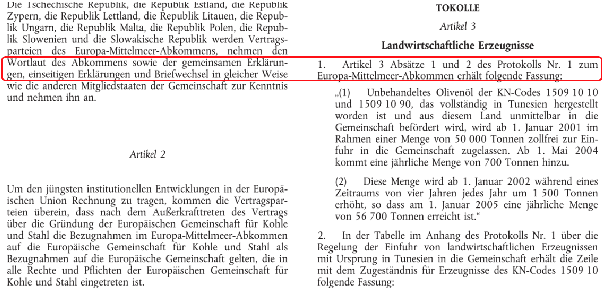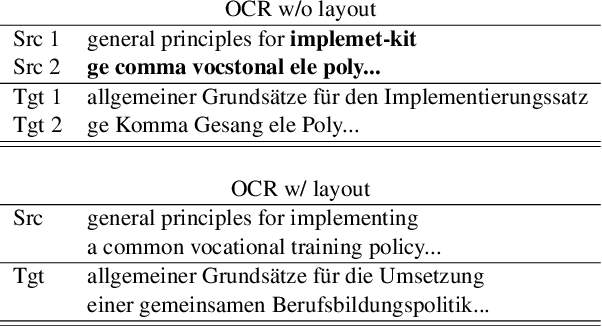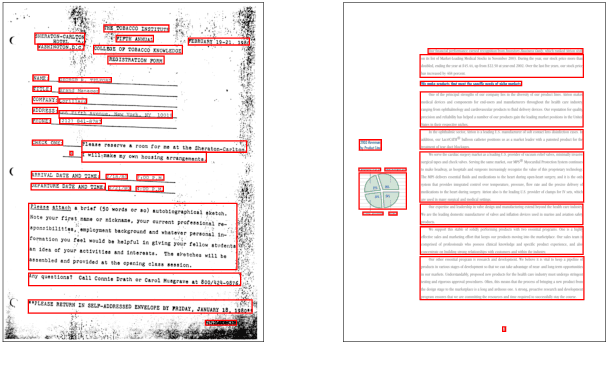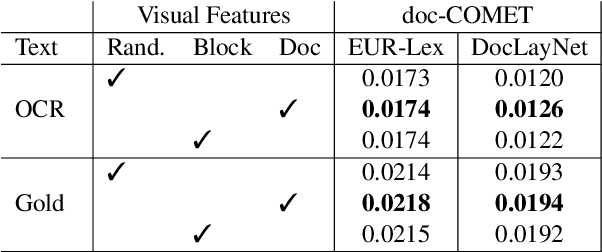Yoshinari Fujinuma
M3T: A New Benchmark Dataset for Multi-Modal Document-Level Machine Translation
Jun 12, 2024



Abstract:Document translation poses a challenge for Neural Machine Translation (NMT) systems. Most document-level NMT systems rely on meticulously curated sentence-level parallel data, assuming flawless extraction of text from documents along with their precise reading order. These systems also tend to disregard additional visual cues such as the document layout, deeming it irrelevant. However, real-world documents often possess intricate text layouts that defy these assumptions. Extracting information from Optical Character Recognition (OCR) or heuristic rules can result in errors, and the layout (e.g., paragraphs, headers) may convey relationships between distant sections of text. This complexity is particularly evident in widely used PDF documents, which represent information visually. This paper addresses this gap by introducing M3T, a novel benchmark dataset tailored to evaluate NMT systems on the comprehensive task of translating semi-structured documents. This dataset aims to bridge the evaluation gap in document-level NMT systems, acknowledging the challenges posed by rich text layouts in real-world applications.
A Multi-Modal Multilingual Benchmark for Document Image Classification
Oct 25, 2023



Abstract:Document image classification is different from plain-text document classification and consists of classifying a document by understanding the content and structure of documents such as forms, emails, and other such documents. We show that the only existing dataset for this task (Lewis et al., 2006) has several limitations and we introduce two newly curated multilingual datasets WIKI-DOC and MULTIEURLEX-DOC that overcome these limitations. We further undertake a comprehensive study of popular visually-rich document understanding or Document AI models in previously untested setting in document image classification such as 1) multi-label classification, and 2) zero-shot cross-lingual transfer setup. Experimental results show limitations of multilingual Document AI models on cross-lingual transfer across typologically distant languages. Our datasets and findings open the door for future research into improving Document AI models.
Diable: Efficient Dialogue State Tracking as Operations on Tables
May 26, 2023Abstract:Sequence-to-sequence state-of-the-art systems for dialogue state tracking (DST) use the full dialogue history as input, represent the current state as a list with all the slots, and generate the entire state from scratch at each dialogue turn. This approach is inefficient, especially when the number of slots is large and the conversation is long. In this paper, we propose Diable, a new task formalisation that simplifies the design and implementation of efficient DST systems and allows one to easily plug and play large language models. We represent the dialogue state as a table and formalise DST as a table manipulation task. At each turn, the system updates the previous state by generating table operations based on the dialogue context. Extensive experimentation on the MultiWoz datasets demonstrates that Diable (i) outperforms strong efficient DST baselines, (ii) is 2.4x more time efficient than current state-of-the-art methods while retaining competitive Joint Goal Accuracy, and (iii) is robust to noisy data annotations due to the table operations approach.
Comparing Biases and the Impact of Multilingual Training across Multiple Languages
May 18, 2023Abstract:Studies in bias and fairness in natural language processing have primarily examined social biases within a single language and/or across few attributes (e.g. gender, race). However, biases can manifest differently across various languages for individual attributes. As a result, it is critical to examine biases within each language and attribute. Of equal importance is to study how these biases compare across languages and how the biases are affected when training a model on multilingual data versus monolingual data. We present a bias analysis across Italian, Chinese, English, Hebrew, and Spanish on the downstream sentiment analysis task to observe whether specific demographics are viewed more positively. We study bias similarities and differences across these languages and investigate the impact of multilingual vs. monolingual training data. We adapt existing sentiment bias templates in English to Italian, Chinese, Hebrew, and Spanish for four attributes: race, religion, nationality, and gender. Our results reveal similarities in bias expression such as favoritism of groups that are dominant in each language's culture (e.g. majority religions and nationalities). Additionally, we find an increased variation in predictions across protected groups, indicating bias amplification, after multilingual finetuning in comparison to multilingual pretraining.
Match the Script, Adapt if Multilingual: Analyzing the Effect of Multilingual Pretraining on Cross-lingual Transferability
Mar 21, 2022



Abstract:Pretrained multilingual models enable zero-shot learning even for unseen languages, and that performance can be further improved via adaptation prior to finetuning. However, it is unclear how the number of pretraining languages influences a model's zero-shot learning for languages unseen during pretraining. To fill this gap, we ask the following research questions: (1) How does the number of pretraining languages influence zero-shot performance on unseen target languages? (2) Does the answer to that question change with model adaptation? (3) Do the findings for our first question change if the languages used for pretraining are all related? Our experiments on pretraining with related languages indicate that choosing a diverse set of languages is crucial. Without model adaptation, surprisingly, increasing the number of pretraining languages yields better results up to adding related languages, after which performance plateaus. In contrast, with model adaptation via continued pretraining, pretraining on a larger number of languages often gives further improvement, suggesting that model adaptation is crucial to exploit additional pretraining languages.
Semi-Supervised Joint Estimation of Word and Document Readability
Apr 27, 2021



Abstract:Readability or difficulty estimation of words and documents has been investigated independently in the literature, often assuming the existence of extensive annotated resources for the other. Motivated by our analysis showing that there is a recursive relationship between word and document difficulty, we propose to jointly estimate word and document difficulty through a graph convolutional network (GCN) in a semi-supervised fashion. Our experimental results reveal that the GCN-based method can achieve higher accuracy than strong baselines, and stays robust even with a smaller amount of labeled data.
Why Overfitting Isn't Always Bad: Retrofitting Cross-Lingual Word Embeddings to Dictionaries
May 01, 2020


Abstract:Cross-lingual word embeddings (CLWE) are often evaluated on bilingual lexicon induction (BLI). Recent CLWE methods use linear projections, which underfit the training dictionary, to generalize on BLI. However, underfitting can hinder generalization to other downstream tasks that rely on words from the training dictionary. We address this limitation by retrofitting CLWE to the training dictionary, which pulls training translation pairs closer in the embedding space and overfits the training dictionary. This simple post-processing step often improves accuracy on two downstream tasks, despite lowering BLI test accuracy. We also retrofit to both the training dictionary and a synthetic dictionary induced from CLWE, which sometimes generalizes even better on downstream tasks. Our results confirm the importance of fully exploiting training dictionary in downstream tasks and explains why BLI is a flawed CLWE evaluation.
A Resource-Free Evaluation Metric for Cross-Lingual Word Embeddings Based on Graph Modularity
Jun 05, 2019



Abstract:Cross-lingual word embeddings encode the meaning of words from different languages into a shared low-dimensional space. An important requirement for many downstream tasks is that word similarity should be independent of language - i.e., word vectors within one language should not be more similar to each other than to words in another language. We measure this characteristic using modularity, a network measurement that measures the strength of clusters in a graph. Modularity has a moderate to strong correlation with three downstream tasks, even though modularity is based only on the structure of embeddings and does not require any external resources. We show through experiments that modularity can serve as an intrinsic validation metric to improve unsupervised cross-lingual word embeddings, particularly on distant language pairs in low-resource settings.
Exploiting Cross-Lingual Subword Similarities in Low-Resource Document Classification
Dec 22, 2018



Abstract:Text classification must sometimes be applied in situations with no training data in a target language. However, training data may be available in a related language. We introduce a cross-lingual document classification framework (CACO) between related language pairs. To best use limited training data, our transfer learning scheme exploits cross-lingual subword similarity by jointly training a character-based embedder and a word-based classifier. The embedder derives vector representations for input words from their written forms, and the classifier makes predictions based on the word vectors. We use a joint character representation for both the source language and the target language, which allows the embedder to generalize knowledge about source language words to target language words with similar forms. We propose a multi-task objective that can further improve the model if additional cross-lingual or monolingual resources are available. CACO models trained under low-resource settings rival cross-lingual word embedding models trained under high-resource settings on related language pairs.
 Add to Chrome
Add to Chrome Add to Firefox
Add to Firefox Add to Edge
Add to Edge